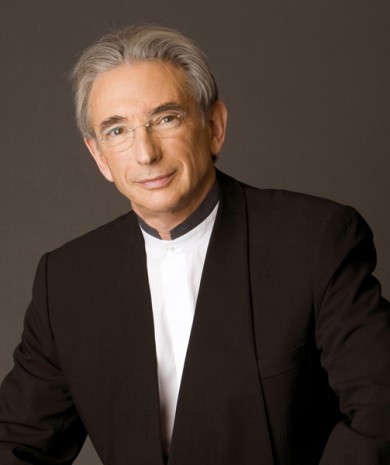MTT, New World Symphony open season with a mighty sound

Michael Tilson Thomas led the New World Symphony in its season-opening concert featuring music of Smetana, Schumann, Janacek and James Lee III Saturday night.
After the speeches and ceremonies that marked the launch of the New World Symphony’s new campus in Miami Beach last year, the orchestra’s season-opening concert took place Saturday with a pleasant absence of pomp.
Founder and artistic director Michael Tilson Thomas strode onto the stage of the modernist new performing arts center, pointed at the snare drum and everyone stood for The Star Spangled Banner. After that it was down to business, with a program of festive, triumphant works that seemed designed to show off the orchestra’s best qualities.
The New World Symphony, which serves as a finishing school for young conservatory graduates, turns over about a third of its members every year as the “fellows” go on to posts with professional orchestras or other full-time jobs. There was no evidence of any roughness or technical difficulties as the new members settled in Saturday, even though the program included complex, technically demanding works that would have exposed any problems.
Strings ripped through the intricate, lightning-fast passages of the Overture to Smetana’s opera The Bartered Bride, with an energetic, razor-sharp performance that led Tilson Thomas to have the string section rise for a bow of its own at the end.
The young Spanish pianist Javier Perianes joined the orchestra for Schumann’s Piano Concerto. Perianes plays in a strikingly diffident manner, his hands close to the keyboard, rarely rising above mezzo-forte, the polar opposite of the theatrical, keyboard-pounding virtuoso. The Schumann concerto, of course, doesn’t call for much keyboard pounding, and Perianes’ touch was so articulate that the complex filigrees of notes in the first and last movements came through clearly over the orchestra, despite the pianist’s quiet style.
But there were times when more robust playing seemed called for, as in the third movement’s triumphant coda, with the piano and orchestra engaging in a joyous dialogue that would have benefited from greater energy from the soloist. Perianes’ playing contrasted sharply with that of the orchestra, which gave muscular accounts of the orchestral passages. As an encore, the Spanish pianist played Chopin’s Mazurka in A minor, Op. 17, No. 4, where his gentle style brought out the work’s melancholy lyricism.
The orchestra gave the world premiere of James Lee III’s Sukkot Through Orion’s Nebula, a work intended to evoke the spirit of the Jewish harvest festival and the arrival of the Messiah from the Orion constellation, as described in the Hebrew Bible. In ten minutes or so of music, Lee skillfully traverses an enormous range of moods, effectively using the orchestra to portray the religion’s ancient roots, the celestial source of the Messiah and the jubilation of his arrival.
After a solemn, dissonant fanfare in brass and percussion, the work proceeded into a section in which winds, strings and xylophone created a mysterious, galactic mood. Lee’s harmonic language is generally tonal but highly complex, with dissonances that give the music an otherworldly expression — feeling either very new or very old. This contributed to the work’s effective ending, in which strings, winds, brass and percussion join for a passage of maximum volume that closes with a full stop.
Janáček’s Sinfonietta, a 1926 work written to celebrate Czech independence, calls for extra brass players, so the orchestra was joined by young musicians from the University of Miami’s Frost School of Music. Such added weight of brass can be accompanied by a loss of precision, but that was not the case Saturday. Deployed around the small auxiliary stages that stand above the main stage, the brass gave a performance that was stirring without crowding out the rest of the orchestra. In the “Queen’s Monastery” section, trombones and tuba achieved a rounded, refined tone in the chords with which they accompanied the yearning melodies in the strings and winds.
The theatrical closing movement is crucial, building to a great climax and calling on all sections to give it everything. The New World and Tilson Thomas delivered a terrific finale, with powerful brass fanfares that never drowned out the strings, a brilliant, beautifully balanced coda that made your ribcage vibrate without ever losing clarity.
The concert was one of 16 that will be broadcast live this season on a projection wall facing the hall’s adjacent park. Hundreds of people sat in the adjacent park under steady rain, many having brought umbrellas.
The New World Symphony repeats the program today at 2 p.m. nws.edu, 305-673-3331.
Posted in Performances
Leave a Comment
Sun Oct 16, 2011
at 1:23 pm
No Comments